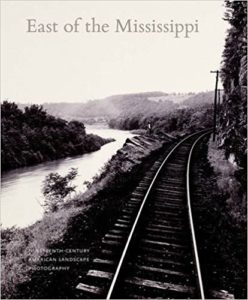
East of the Mississippi: Nineteenth-Century American Landscape Photography By Diane Waggoner, Russell Lord, Jennifer Raab. Yale University Press
European history is based on countless ruins of antiquity, while American history resides in stories from the natural world. Early Europeans and their descendants in North America used visual art to preserve images that so overwhelmed them. By 1839, when the art of photography arrived in the United States, it presented a means to meld both art and science into a medium to record details with truth and accuracy. European history is based on countless ruins of antiquity, while American history resides in stories from the natural world. Early Europeans and their descendants in North America used visual art to preserve images that so overwhelmed them. By 1839, when the art of photography arrived in the United States, it presented a means to meld both art and science into a medium to record details with truth and accuracy.
At that time the United States was made up of twenty-six states; twenty more would be added by the end of the 19th Century. The East was much more established while the West was rapidly growing. Many photographers turned to the new and unique landscapes West of the Mississippi. However, others documented the changes and the beauties East of the Mississippi.
Some of the most popular early subjects in the East were Niagara Falls, the Falls of St. Anthony located near St. Paul, the Hudson River and the environs of West Point, as well as booming towns like St. Louis, Natchez, and New Orleans. Few of the works focused on humans. If there were people in the work, they were enjoying the landscape also. Seldom were any photographs posed or staged.
These early photographs became an inspiration for travel, especially to Niagara Falls. As such, a collection over time graphically told the story of changes made by progress and by nature.
The 19th century saw the apex of agriculture with the rise of industry. Everything from haystacks to wildflowers captured the eye of the photographer, all in black and white. Bucolic farms in the 1840s and 1850s were replaced with mills and railroads transporting farm produce to city dwellers. Bales and bales of cotton on steamboats fascinated the artists. Countless steamboats lined up at docks up and down the Mississippi, ready to take to harvests to Europeans and New England ports where the white fluffy stuff would be converted into fabric and clothing.
Early photography documented the loss of first growth forests. Deforestation and sawmills were subjects of the camera. Of course, such men as Matthew Brady covered the Civil War. However, others looked at the aftermath of battles where trees were defoliated and fallen. Rifle pits tore up the ground.
Photography also captured cultural changes east of the Mississippi. Cemeteries in rural areas became a site to mourn the dead with grace and serenity. Urban growth was documented as it changed the former smaller towns and communities. In all the introduction of photography gave us a better perspective of a life transformed in the United States.
New Orleans Museum of Art worked with the National Gallery of Art Washington to create an exceptional exhibit. Although the exhibit closed January 7, 2018, Diane Waggoner along with Russell Lord and Jennifer Raab created a superb book East of the Mississippi: Nineteenth-Century American Landscape Photography, Yale University Press.
As an aside, it wasn’t until 1888 that George Eastman perfected the first portable, handheld camera that required little technical knowledge. The world was changing.
